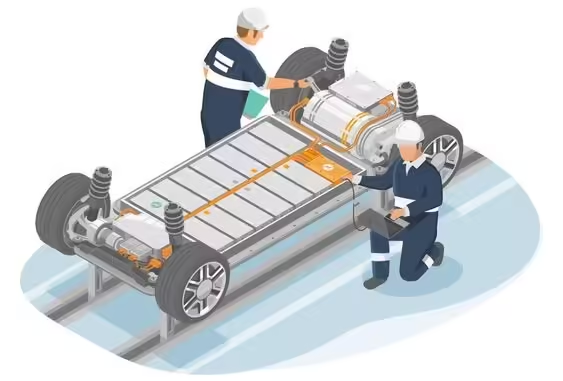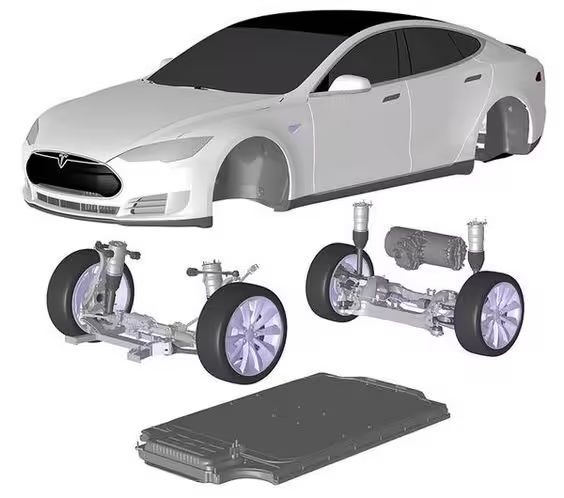
As the world transitions toward cleaner energy solutions and more sustainable modes of transportation, electric vehicles (EVs) have taken center stage in the fight against climate change. With their promise of zero emissions and improved air quality, EVs have become an integral part of global efforts to reduce carbon footprints. However, behind the benefits of EVs lies a critical challenge—the sustainability of the lithium-ion batteries that power them. While EVs themselves produce no tailpipe emissions, the lifecycle of their batteries, from production to disposal, has significant environmental implications.
The future of EV adoption relies heavily on creating sustainable solutions for handling these batteries at the end of their useful life. This blog explores the environmental impact of lithium-ion batteries, the challenges of recycling them, and the innovative technologies and processes that are emerging to make EV battery recycling a critical part of the green revolution.

1. The Environmental Impact of Lithium-Ion Batteries
Lithium-ion batteries are the driving force behind electric vehicles. They are lightweight, rechargeable, and capable of storing large amounts of energy, making them ideal for EVs. However, the production and disposal of these batteries raise several environmental concerns.
Mining of Raw Materials:
One of the most significant environmental impacts associated with lithium-ion batteries stems from the extraction of raw materials such as lithium, cobalt, nickel, and manganese. Mining for these materials is energy-intensive and often involves significant ecological disruption, including deforestation, water pollution, and soil degradation. Additionally, cobalt mining, particularly in the Democratic Republic of Congo, is associated with serious human rights issues, including child labor and unsafe working conditions.
Energy-Intensive Manufacturing:
The process of manufacturing lithium-ion batteries is highly energy-consuming, often relying on electricity generated from fossil fuels. This leads to significant greenhouse gas emissions, which, paradoxically, detracts from the overall environmental benefits of electric vehicles. The production of a single EV battery can account for a substantial portion of an EV’s total lifetime emissions, depending on where and how the battery is manufactured.
Battery Disposal and Pollution:
At the end of their lifespan, improperly discarded lithium-ion batteries can pose environmental hazards. Toxic chemicals, such as lead and acids, can leach into the soil and water, causing pollution and potential harm to ecosystems and human health. This creates a pressing need for effective recycling and disposal methods.
Key takeaway:
While EVs reduce air pollution and carbon emissions, the environmental cost of producing and disposing of lithium-ion batteries must be addressed to make EVs a truly sustainable option.
2. The Importance of Recycling EV Batteries
The widespread adoption of electric vehicles has led to an increasing number of lithium-ion batteries reaching the end of their lifecycle. Without effective recycling methods, these batteries risk ending up in landfills, where they can leak hazardous materials into the environment.
Recycling EV batteries offers several key benefits:
- Preservation of Resources: By recycling lithium-ion batteries, valuable materials such as lithium, cobalt, nickel, and copper can be recovered and reused. This reduces the need for additional mining, thus conserving natural resources and reducing the environmental impact of battery production.
- Waste Reduction: Recycling prevents batteries from ending up in landfills, where they could leak harmful chemicals. Additionally, recycling reduces the overall volume of electronic waste, which is becoming a growing concern worldwide.
- Economic Benefits: The ability to recover expensive and scarce materials from used batteries provides economic incentives for both businesses and consumers. As demand for lithium-ion batteries continues to rise with the growth of the EV market, recycling could help stabilize material prices and reduce supply chain risks.
Recycling also aligns with the principles of a circular economy, in which products and materials are kept in use for as long as possible, reducing waste and conserving resources. For EVs to be part of a truly sustainable transportation ecosystem, recycling their batteries is essential.
Key takeaway:
Recycling EV batteries is critical for reducing environmental harm, conserving valuable resources, and supporting a sustainable circular economy.

3. Challenges in Lithium-Ion Battery Recycling
Despite the clear benefits of recycling EV batteries, the process is not without its challenges. The complexity of lithium-ion batteries makes recycling them both technically difficult and economically challenging.
Complexity of Battery Design:
Lithium-ion batteries are composed of various materials, including metals, plastics, and electrolytes. Separating and recovering these materials requires sophisticated technology, and some materials, such as the electrolyte, are difficult to extract efficiently. Moreover, different battery manufacturers use different chemistries and designs, further complicating the recycling process.
Economic Viability:
Currently, recycling lithium-ion batteries is often more expensive than mining new materials. The cost of collecting, transporting, and processing used batteries can be high, particularly if the batteries are not designed with recycling in mind. Additionally, the value of the recovered materials may not always offset the cost of the recycling process, making it less appealing for businesses to invest in large-scale battery recycling operations.
Recycling Infrastructure:
The existing recycling infrastructure is not yet capable of handling the anticipated surge in battery waste. While the number of EVs on the road is rapidly increasing, the infrastructure needed to collect, process, and recycle their batteries is still in its infancy in many parts of the world. To accommodate the growing demand for battery recycling, significant investment in recycling facilities and technologies is required.
Key takeaway:
Recycling lithium-ion batteries presents technical and economic challenges, including the complexity of battery design, the high cost of recycling, and the need for better infrastructure.
4. Innovations in EV Battery Recycling
Fortunately, several innovative technologies and processes are being developed to address the challenges of EV battery recycling. These advancements offer the potential to make recycling more efficient, cost-effective, and environmentally friendly.
Hydrometallurgical and Pyrometallurgical Processes:
Two common methods for recycling lithium-ion batteries are hydrometallurgical and pyrometallurgical processes. In pyrometallurgy, batteries are smelted at high temperatures to recover valuable metals like cobalt, nickel, and copper. However, this method is energy-intensive and can result in the loss of some materials.
Hydrometallurgy, on the other hand, uses aqueous solutions to leach out metals from the battery. This process is more environmentally friendly than pyrometallurgy and allows for the recovery of a wider range of materials, including lithium. However, both methods have limitations in terms of efficiency and scalability.
Direct Recycling:
One of the most promising innovations in EV battery recycling is direct recycling, which aims to recover and reuse the battery’s active materials with minimal processing. Instead of breaking down batteries into their individual components, direct recycling preserves materials like the cathode and anode for reuse in new batteries. This method not only reduces the energy required for recycling but also preserves the quality of the materials, potentially leading to cost savings and improved battery performance.
Second-Life Applications:
Another innovative approach to EV battery sustainability is second-life applications. Even after a battery has reached the end of its useful life in an electric vehicle, it may still have sufficient capacity for less demanding tasks, such as energy storage for homes or businesses. Repurposing EV batteries for second-life applications extends their lifecycle, reducing the need for immediate recycling and lowering the environmental impact of battery production.
Collaborations and Government Policies:
Governments and industry leaders are also playing a crucial role in driving innovation in battery recycling. Several governments, including those in the European Union and China, have implemented regulations requiring battery manufacturers to take responsibility for the end-of-life management of their products. Additionally, companies like Tesla, Volkswagen, and BMW are investing in closed-loop recycling systems, which aim to create a sustainable supply chain by recovering and reusing materials from old batteries.
Key takeaway:
Innovations such as direct recycling, second-life applications, and policy-driven collaborations are making EV battery recycling more efficient and sustainable.
5. The Future of EV Battery Recycling and Sustainability
The growing EV market presents both challenges and opportunities for sustainability. As the number of electric vehicles on the road increases, so does the need for scalable, efficient recycling solutions for lithium-ion batteries. Continued innovation in recycling technologies, along with investment in infrastructure and supportive government policies, will be critical to ensuring that EVs remain a cornerstone of the green transition.
The future of EV battery recycling is likely to be shaped by a combination of technological advancements, economic incentives, and environmental regulations. As new methods for recovering battery materials emerge, the cost of recycling will likely decrease, making it more economically viable. At the same time, second-life applications for batteries will continue to reduce the demand for new battery production, further contributing to the sustainability of the EV ecosystem.
Key takeaway:
The future of EV battery recycling will depend on continued innovation, government support, and industry collaboration to create a more sustainable, circular economy for electric vehicles.
Conclusion
As the world moves towards greater adoption of electric vehicles, addressing the sustainability of lithium-ion batteries is critical to the long-term success of the EV revolution. While there are significant environmental and technical challenges associated with the production, use, and disposal of EV batteries, innovations in recycling and second-life applications offer promising solutions.
By investing in advanced recycling technologies and building the necessary infrastructure, we can reduce the environmental impact of lithium-ion batteries, preserve valuable resources, and support the transition to a greener, more sustainable transportation system. The future of EV battery recycling is bright, and with continued progress, electric vehicles can live up to their full potential as a key component of a low-carbon future.

Leave a Reply